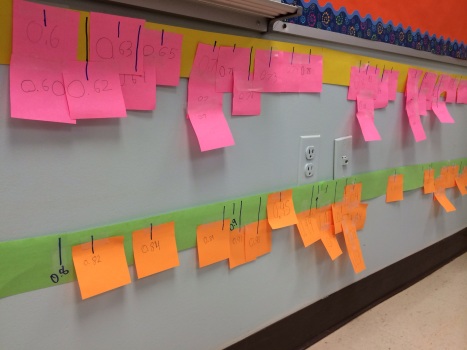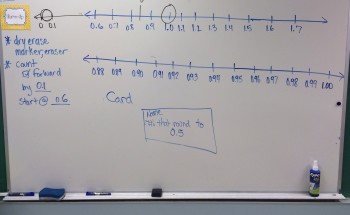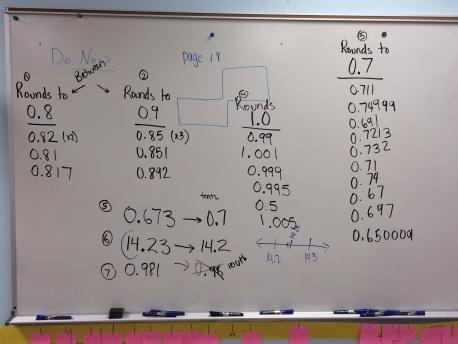The concept of Counting Circles was introduced to me by Sadie, either during TMC or Global Math (thought, I’m not sure exactly). Jessica Shumway’s book, Number Sense Routines: Building Numerical Literacy Every Day in Grades K-3, taught me a little more. Last year, I found a template here to use for counting routines. Eagerly I printed the template on card stock and laminated them, all ready for use in my classroom. But, they sat on the shelf. It took me quite a while to integrate them into my classroom. The perfect opportunity came when my 5th graders began their exploration of rounding decimal numbers.
Counting by tenths or hundredths, after all, is a prerequisite skill for rounding to the nearest tenth or hundredth. Right before our break, we compared decimals by creating a huge number line.
 That work led us directly into counting forwards by one-tenth starting at 0.6. Each student used a dry erase marker to record his or her counting on the template. When reviewing the counting, the numbers were read aloud by the students (which gave me a chance to quickly assess how accurately students can read decimal numbers), and were recorded on a number line. My students moved seamlessly through the “count by one-tenth” examples when the only digit was in the tenths place, easily regrouping ten-tenths as 1 whole. We then started counting by one-tenth starting at 4.28. That was definitely trickier for some, who thought that 4.29 was one-tenth higher. But as soon as I asked “Is 4.29 one-tenth more or one-hundredth more than 4.28? Why?”, those students realized that they increased the value of the wrong digit. We did some additional practice counting both forwards and backwards by tenths and hundredths (next week I would like to count by 0.2 and 0.02).
That work led us directly into counting forwards by one-tenth starting at 0.6. Each student used a dry erase marker to record his or her counting on the template. When reviewing the counting, the numbers were read aloud by the students (which gave me a chance to quickly assess how accurately students can read decimal numbers), and were recorded on a number line. My students moved seamlessly through the “count by one-tenth” examples when the only digit was in the tenths place, easily regrouping ten-tenths as 1 whole. We then started counting by one-tenth starting at 4.28. That was definitely trickier for some, who thought that 4.29 was one-tenth higher. But as soon as I asked “Is 4.29 one-tenth more or one-hundredth more than 4.28? Why?”, those students realized that they increased the value of the wrong digit. We did some additional practice counting both forwards and backwards by tenths and hundredths (next week I would like to count by 0.2 and 0.02). To transition into the rounding portion of the lesson, my students wrote a number on their whiteboards between 0.8 and 0.9. Applying what they already know about rounding whole numbers, I asked students to go to one side of the room if their number rounded to 0.8 and to the other if their number rounded to 0.9. Students on each side of the room discussed why they were standing where they were. Of course, the prevailing explanation was a recitation rounding rules. But, I pressed my students to explain why the rules work. With some guidance, they determined that since 0.85 is halfway between 0.8 and 0.9, numbers greater than or equal to 0.85 would round to 0.9 and any number less than 0.85 would round to 0.8. After a few more practice examples, we repeated the activity again, this time writing numbers between 0.88 and 0.89, and rounded them to the nearest hundredth. The exploration continued when I asked students to again go to one side of the room if their number rounded to 0.8 and to the other if their number rounded to 0.9.
To transition into the rounding portion of the lesson, my students wrote a number on their whiteboards between 0.8 and 0.9. Applying what they already know about rounding whole numbers, I asked students to go to one side of the room if their number rounded to 0.8 and to the other if their number rounded to 0.9. Students on each side of the room discussed why they were standing where they were. Of course, the prevailing explanation was a recitation rounding rules. But, I pressed my students to explain why the rules work. With some guidance, they determined that since 0.85 is halfway between 0.8 and 0.9, numbers greater than or equal to 0.85 would round to 0.9 and any number less than 0.85 would round to 0.8. After a few more practice examples, we repeated the activity again, this time writing numbers between 0.88 and 0.89, and rounded them to the nearest hundredth. The exploration continued when I asked students to again go to one side of the room if their number rounded to 0.8 and to the other if their number rounded to 0.9.
After a few seconds one student cried out, “But we are all going to be on this [0.9] side!”
“Why?” I asked.
“Because all of our numbers are greater than 0.85, so we all round to 0.9.”
To challenge their thinking even further, the students were asked to write numbers that round to a particular place. Some of the examples are pictured below. As students shared their numbers, they were recorded on the board and the reasonableness of each was determined.
 The lesson continued with rounding numbers to a particular place. My students had to prove their solution by using a number line. I quickly assessed their understanding with an exit card. Students were asked to write two numbers, one greater than 0.5 and one less than 0.5, that round to 0.5. That card gave me valuable insight to their learning.
The lesson continued with rounding numbers to a particular place. My students had to prove their solution by using a number line. I quickly assessed their understanding with an exit card. Students were asked to write two numbers, one greater than 0.5 and one less than 0.5, that round to 0.5. That card gave me valuable insight to their learning.
While placing numbers on the number line was challenging for some, the lesson was an overall success! With more practice counting by tenths, hundredths, or even thousandths, students will gain greater confidence and comfort with decimals.
Adrienne 🙂
Love your blog, your tweets, and this activity. We’ve just started experimenting with counting circles in one of our grade 5 classrooms. We counted by tenths from 0 to 26.2 (we were in the middle of a 3-act problem involving the classroom teacher’s Chicago marathon run). Kids loved it, and one thought she recognized a pattern in the numbers she said. I think I’ll have the kids count again and use the template to have them record only the numbers they say when it’s their turn and look for a pattern. Then they can cut out the individual squares and use them to construct a class number line.
Creating a number line from the squares is a great idea! Definitely need to keep in it in mind for the next time.
I actually brought the same task to a 4th grade classroom for both rounding whole numbers and rounding with money. The skip counting and templates really helped the students round to the nearest dollar.
Something that helps some of my folks is drawing a hill on the number line so that the vertex of the hill is at the halfway point — which way would a ball roll?